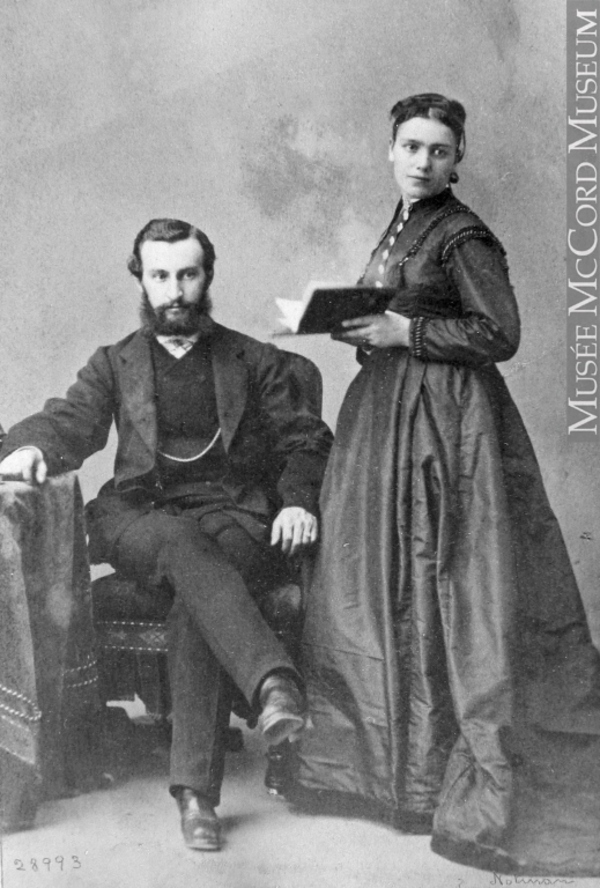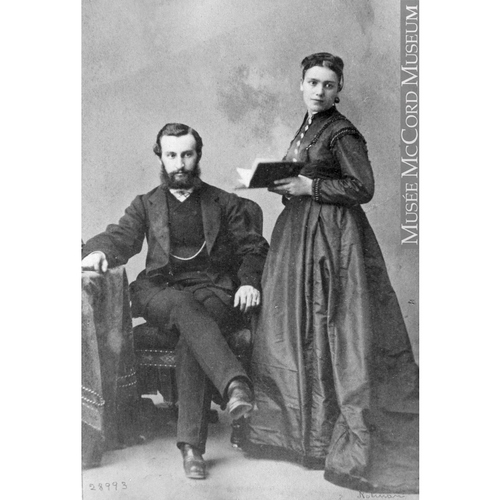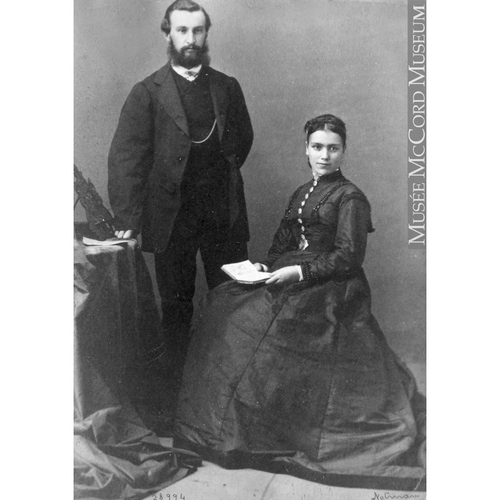
Source: Link
BREAKEY, JOHN, businessman; b. 9 April 1846 in Chaudière Mills (Breakeyville), Lower Canada, sixth of the nine children of Hans Denaston Breakey and Theresa Murray; m. 5 Nov. 1867 in Lévis, Que., Helen Anderson, half-sister of the Reverend Duncan Anderson, and they had four sons and five daughters; d. 26 June 1911 in Breakeyville.
In 1830, sometime after the demise of the family’s linen-bleaching business, which had been started in Ireland around 1700 by Huguenot ancestors Jean and Guillaume de Brequet, John Breakey’s father, Hans Denaston, aged 20, emigrated from Rockcorry (Republic of Ireland). According to family tradition, he had intended to join relatives in Sullivan County, N.Y., but was shipwrecked in the Gulf of St Lawrence. He made his way to Pointe-Lévy (Lévis), Lower Canada, where he decided to stay. Initially, he worked in a lumberyard and later he acquired his own lumberyard, from which he shipped pit-props to England. He also operated a grocery in his home in Pointe-Lévy.
In 1846, the year John was born, Hans formed a partnership with his brother-in-law Charles King, father of James*, to erect a sawmill at Chaudière Mills and to acquire timberlands in the Beauce region. In so doing, the two men pioneered the timber business along the Rivière Chaudière and its tributaries. In 1846 and 1847 they acquired contracts to cut pine in the southern Beauce and in the spring of 1847 they initiated yearly timber drives on the Chaudière between the southern Beauce and Chaudière Mills which would continue uninterrupted until 1947. At the height of the timber drives during the 20th century the firm would employ up to 2,000 men each spring.
John Breakey was educated at the private grammar school of the Reverend Duncan Anderson, minister of St Andrew’s Presbyterian Church in Lévis. He went on to be apprenticed in every branch of the sawmilling and lumber-manufacturing industries and became familiar with machines for both sawmill and railway construction. When his father died in 1863, the family business was taken over by the eldest living son, William Isaiah, who was 21 at the time. Family tradition has it that John assumed management of the business shortly thereafter, at a time when it was failing. He succeeded in reversing its fortunes dramatically.
In 1870 William Isaiah retired from the business and John formed a partnership with his cousin Henry King and with James Patton as Henry King and Company. The following year Patton sold his interest to his two partners, who continued under the name King and Breakey. Eight years later Breakey bought out King’s share. He thus became the sole proprietor of 453 square miles of timberlands in Beauce county, as well as of the sawmilling facilities at Chaudière Mills. In 1884 he acquired an additional 57 square miles in the townships of Metgermette-Nord and Metgermette-Sud. By 1895 he employed 600 men and 300 horses in the lumber camps during the winter; 200 men and 20 horses worked at the mill and elsewhere during the summer. The mill processed 33,000,000 board feet of lumber per year into beams, planks, laths, railway ties, and telephone and telegraph poles. About ten years later an historian of the lumber industry, James Elliott Defebaugh, described Breakey’s mill as “one of the largest if not the largest spruce deal mill in the province of Quebec.” By 1910 plans were being made for the construction of another mill, steam-powered, not far from the first.
Initially, oxen and horses hauled the timber from Breakey’s mill to New Liverpool (Saint-Romuald) on the St Lawrence River, where his firm had docking facilities. There it was loaded on schooners for shipment to Quebec City and then overseas. In 1883 Breakey built a six-mile stretch of railway from his mill to Chaudière-Bassin, close to New Liverpool. In 1898 he and other members of his family incorporated the Chaudière Valley Railway Company. The proposed line was to run along the Chaudière from Scott-Jonction (Scott) to Chaudière-Bassin so as to incorporate the section already in operation and then to continue past Lévis to a terminus at deep water, but it was never built.
In addition to being a timber merchant, Breakey was a major shareholder in the Quebec and Lévis Telephone Company, and a director of the Quebec District Railway Company, the Quebec Bridge Company, the Union Bank of Canada, and the Quebec Bank. He served as president of the Quebec Bank from 1898 to 1908. In 1900 his assets were estimated at $400–500,000; he held $21,800 worth of shares in the Quebec Bank and $24,000 in the Union Bank, and he had also invested in mines and mining rights. In August 1899, as president of the Canadian Electric Light Company Limited, he had signed the contract for construction of a hydroelectric dam on the Chaudière which would provide electricity to Lévis and nearby municipalities.
A Presbyterian, Breakey was a governor of Morrin College, Quebec City, and a trustee of St Andrew’s Church there, but he and his wife, Helen, were noted for their acts of charity towards several religious denominations. In 1908 he donated the land, materials, and funds needed for the construction of a Roman Catholic church in Chaudière Mills so that his workers and their families could have easier access to a place of worship. In recognition of these and other contributions, the parish was named Sainte-Hélène in honour of his wife and the municipality was called Sainte-Hélène-de-Breakeyville.
John Breakey died in Breakeyville at the age of 65. He left the management of his extensive timber operations to his wife and three of his sons: Andrew Hans Denaston William, Colin Cathcart, and John (known as Ian). Shortly afterwards, they began production of pulpwood and in 1922 they completely abandoned the manufacture of sawn lumber. In 1947 they added a groundwood mill to their facilities. For over a century, the Breakeys’ lumber operations were the largest economic activity along the Rivière Chaudière. Now the Beauce region has a fully diversified economy and the area is well known for the entrepreneurial spirit of its inhabitants.
ANQ-Q, CE1-66, 25 juill. 1846; CE1-75, 13 mai 1863; CE1-76, 5 nov. 1867; CT1-1, 5 juill. 1911; T11-1/32, no.172 (1911); 33, no.1214 (1920). Presbyterian Hist. Soc. of Ireland (Belfast), T. C. Breakey, memoirs, 1–2. Private arch., Alan Breakey (Bragg Creek, Alta), Corr., John Breakey (Chaudière Mills, Que.) to John Breakey (London), 25 Aug. 1897; John Breakey to Harold Breakey, 15 Oct. 1897. La Semaine commerciale (Québec), 13 sept. 1895. Le Soleil, 31 août 1899. La Beauce et les Beaucerons; portrait d’une région, 1737–1987 (Saint-Joseph-de-Beauce, Qué., 1990). Canadian men and women of the time (Morgan; 1898 and 1912). J. E. Defebaugh, History of the lumber industry of America (2v., Chicago, 1906–7). Pierre Poulin, “Déclin portuaire et industrialisation: l’évolution de la bourgeoisie d’affaires de Québec à la fin du XIXe siècle et au début du XXe siècle” (mémoire de ma, univ. Laval, Québec, 1985). Honorius Provost, Chaudière Kennebec; grand chemin séculaire (Québec, 1974); Sainte-Marie de la Nouvelle-Beauce; histoire civile (Québec, 1970). Qué., Statuts, 1898, c.64; 1899, c.76. Sainte-Hélène-de-Breakeyville, d’hier à aujourd’hui (s.l., 1984). A statutory history of the steam and electric railways of Canada, 1836–1937, with other data relevant to operation of Department of Transport, comp. Robert Dorman (Ottawa, 1938). The storied province of Quebec; past and present, ed. William Wood et al. (5v., Toronto, 1931–32). Robert Vézina et Philippe Angers, Histoire de Saint-Georges de Beauce (Beauceville, Qué., 1935).
Cite This Article
Alan Ross Breakey, “BREAKEY, JOHN,” in Dictionary of Canadian Biography, vol. 14, University of Toronto/Université Laval, 2003–, accessed December 31, 2025, https://www.biographi.ca/en/bio/breakey_john_14E.html.
The citation above shows the format for footnotes and endnotes according to the Chicago manual of style (16th edition). Information to be used in other citation formats:
| Permalink: | https://www.biographi.ca/en/bio/breakey_john_14E.html |
| Author of Article: | Alan Ross Breakey |
| Title of Article: | BREAKEY, JOHN |
| Publication Name: | Dictionary of Canadian Biography, vol. 14 |
| Publisher: | University of Toronto/Université Laval |
| Year of publication: | 1998 |
| Year of revision: | 1998 |
| Access Date: | December 31, 2025 |




